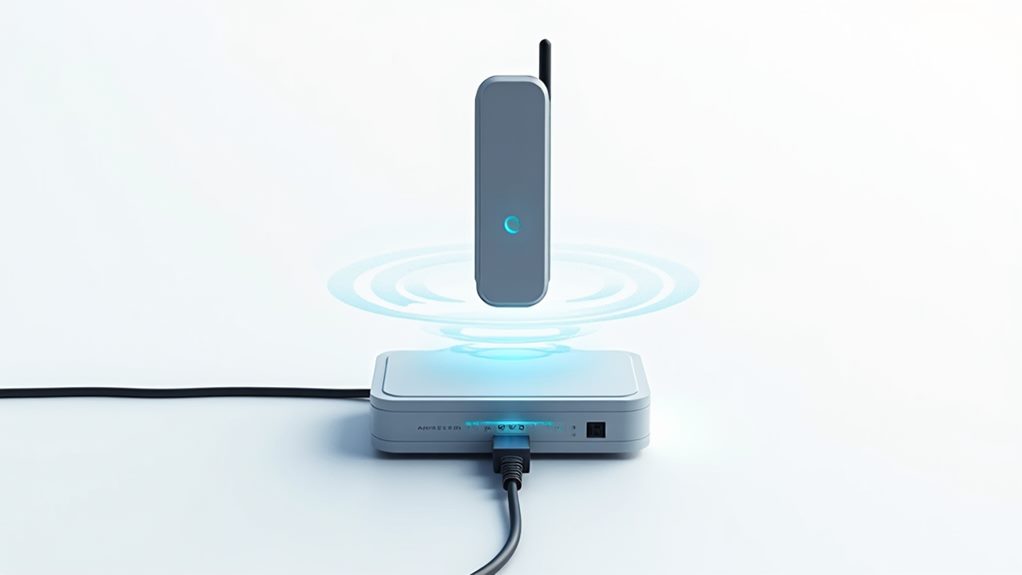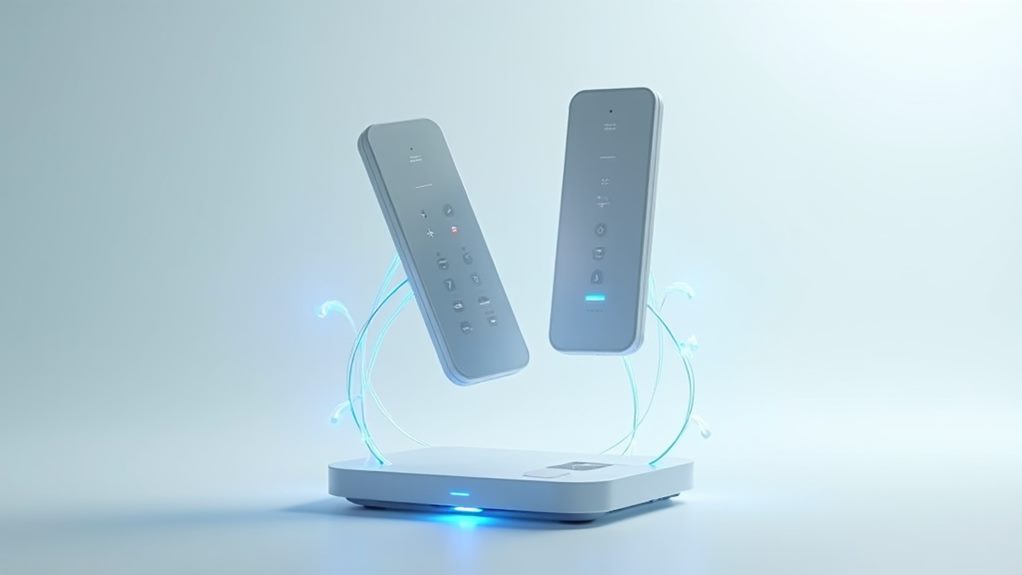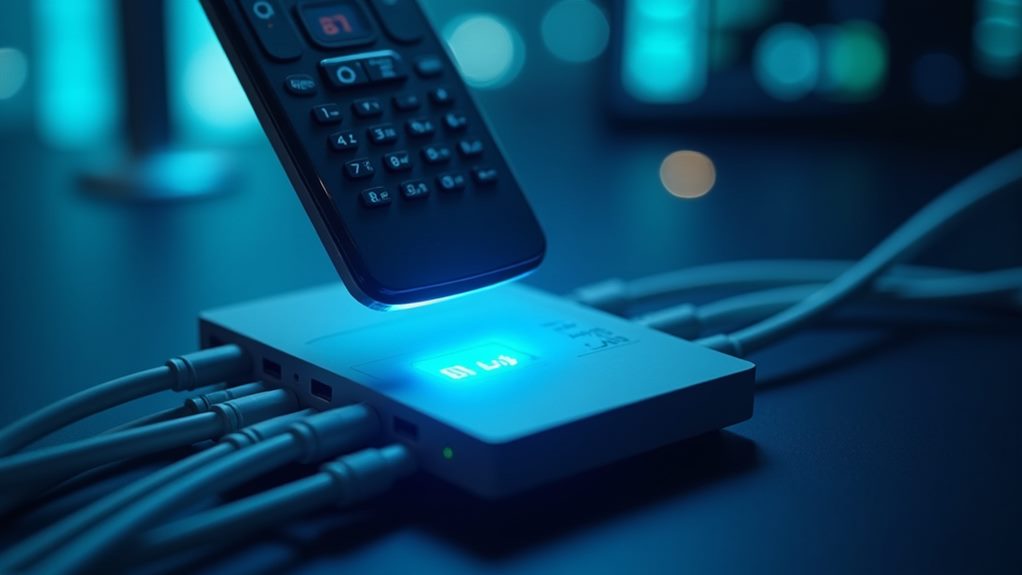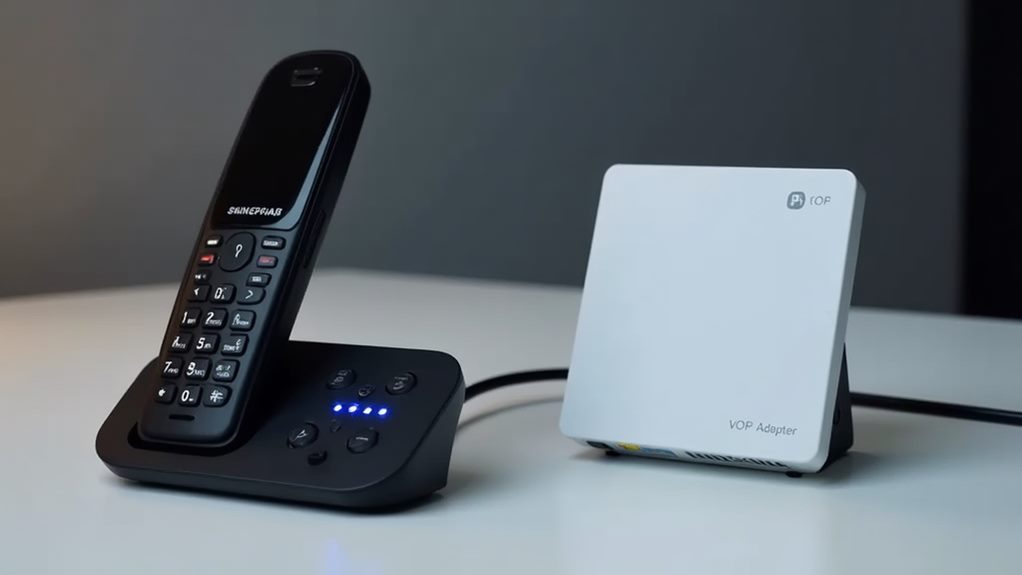Your cordless phone can work with VoIP, but you'll need specific equipment and configurations. Most cordless phones require an Analog Telephone Adapter (ATA) to connect to VoIP services, while some DECT-based models can integrate directly with routers. You'll need a stable internet connection of at least 1 Mbps and proper backup power solutions for reliable operation. Compatibility depends on your phone's model, the VoIP service provider, and whether your system supports features like caller display and 3-way calling. Understanding your specific setup requirements will guarantee successful VoIP integration and peak performance.
Understanding VoIP Phone Compatibility

VoIP compatibility with cordless phones hinges on specific hardware configurations and technical requirements. When you're integrating your existing cordless phone with a VoIP service, you'll need to evaluate several technical factors that determine successful operation.
In addition, the use of Wi-Fi networks for VoIP phones enhances mobility and flexibility, which is essential for remote communication setups. Understanding the role of quality of service settings can also play a key part in maintaining call quality during this integration.
Your cordless phone's base station can connect directly to your router for Digital Voice services, but you'll likely need an Analog Telephone Adapter (ATA) to bridge the gap between analog and digital signals. This device converts your phone's analog signals into digital packets that can travel over the internet, ensuring proper communication through your VoIP system.
While Panasonic DECT phones have proven compatibility with VoIP systems through Digital Voice hubs, you should be aware that not all cordless phones offer full feature support.
You might encounter limitations with certain VoIP functionalities, such as caller display, 3-Way Calling, or Recall buttons. These features may operate differently or not at all, depending on your specific phone model and VoIP service configuration.
Understanding these technical constraints helps you set realistic expectations and make informed decisions about your phone system setup, ensuring you achieve the most effective integration possible.
Adapter Requirements and Setup
In accordance with modern VoIP integration standards, connecting your cordless phone to an internet-based phone service requires an Analog Telephone Adapter (ATA) as the essential bridge component. This device serves as your gateway to VoIP functionality by converting analog signals into digital data packets suitable for internet transmission.
VoIP technology fundamentally changes call transmission by utilizing advanced features and flexibility that traditional systems don't provide.
The adapter requirements center on guaranteeing compatibility between your cordless phone and the ATA's specifications. You'll need to verify that your ATA features standard RJ-11 ports for proper connection to your existing cordless phone system.
During setup, follow the manufacturer's configuration guidelines precisely to establish a stable connection and avoid potential communication disruptions.
To maximize your system's reliability, you'll want to take into account installing a backup battery unit (BBU) for your ATA. This addition guarantees your phone system remains operational during power outages, maintaining your connection to essential communication services.
When implementing your setup, pay particular attention to the ATA's configuration parameters and any specific requirements outlined in your VoIP service provider's documentation. Your success in integrating cordless phones with VoIP technology depends largely on proper adapter selection and meticulous attention to setup procedures.
Types of Cordless Phone Systems

Modern cordless phone systems come in several distinct configurations for use with VoIP technology. These systems can leverage advanced features of VoIP to enhance communication, providing you with options that maximize efficiency and usability.
You'll find DECT-based systems that connect directly to your router, offering seamless integration with digital voice services. These advanced units provide superior compatibility with VoIP platforms while maintaining the wireless freedom you've come to expect from cordless phones.
When selecting a cordless phone system for VoIP use, you'll encounter three primary categories. First, there are VoIP-ready cordless phones that integrate natively with internet telephony services.
Second, you'll find traditional cordless phones that can work with VoIP through adapters, letting you keep your existing handsets while upgrading to digital service.
Third, there are hybrid systems that support both analog and digital connections, offering maximum flexibility for your communication needs.
Your cordless phone options may include models with enhanced features when paired with VoIP services. These can include cloud-based functionality, advanced call management, and improved caller display capabilities.
When choosing a system, you'll want to verify compatibility with your specific VoIP service to guarantee all features function as intended.
Power and Internet Connection Needs
Your VoIP-enabled cordless phone system requires both a stable internet connection with minimum speeds of 100 kbps per line and consistent power to maintain functionality.
You'll need to install an uninterruptible power supply (UPS) or backup battery system to keep your phone service operational during power outages, as VoIP devices won't function without electricity.
To guarantee reliable emergency communications, you should maintain a minimum broadband speed of 1 Mbps and consider keeping a mobile phone as a backup option when internet connectivity is compromised.
Backup Power Requirements
Reliable backup power represents a vital requirement for cordless phones operating on VoIP systems, as these devices won't function during power outages without proper contingencies.
You'll need to implement thorough power backup solutions for both your cordless phone base station and broadband router to maintain uninterrupted VoIP service.
To guarantee continuous connectivity, you should consider installing an Uninterruptible Power Supply (UPS) for your VoIP equipment. This solution safeguards against service interruptions by providing immediate backup power when your main power source fails.
If you're classified as a vulnerable customer, you may qualify for free resilience solutions through providers like BT, including battery backup units (BBUs).
Your backup power strategy must address two essential components: the cordless phone system and the internet infrastructure.
Your broadband router requires consistent power to maintain internet connectivity, which is vital for VoIP functionality. Without a properly powered router, your VoIP service won't work, even if your cordless phone has backup power.
Remember to regularly test your backup power systems and confirm they're adequately maintained to provide reliable service during outages.
Internet Speed Minimums
In accordance with industry standards, VoIP telephony requires specific internet speed thresholds to maintain ideal call quality. You'll need a minimum of 1 Mbps for a single VoIP call, but if you're planning to use multiple lines or conduct other internet activities simultaneously, you should aim for 3-5 Mbps to guarantee peak performance.
Your internet connection's stability is just as important as its speed. When you're using VoIP, you'll want to monitor two key metrics: latency and packet loss. Your connection should maintain latency below 150 milliseconds, while packet loss should remain under 1%.
If either metric exceeds these thresholds, you'll likely experience call quality issues such as delays, echoes, or dropped calls.
To verify your connection meets these requirements, you can run speed tests before implementing your VoIP system. Remember that your actual internet speed may fluctuate throughout the day, so it's wise to test at different times.
Consider upgrading your internet service if your current plan doesn't consistently meet these minimums, as inadequate speeds will compromise your VoIP call quality and reliability.
Emergency Connection Options
While maintaining proper internet speeds guarantees quality VoIP service, power outages can completely disrupt your communication system. Your VoIP and cordless phones require a constant power supply to function, making them vulnerable during blackouts.
To guarantee uninterrupted communication, you'll need to implement reliable battery backup solutions for both your VoIP equipment and internet modem.
Installing a battery backup unit (BBU) for your VoIP system provides essential emergency communication capabilities when standard power fails. You'll want to connect your VoIP adapter, modem, and router to the BBU to maintain functionality.
Many service providers offer resilience solutions specifically designed for customers who depend on their communication services.
As part of your emergency preparedness strategy, you should also consider alternative communication methods. Your mobile phone can serve as a backup option, provided cellular networks remain operational.
If you're using a VoIP system in a business or home office setting, it's vital to invest in appropriate backup power solutions.
Contact your VoIP provider to discuss available emergency options and determine which backup systems are compatible with your current setup. This proactive approach guarantees you'll stay connected during critical situations.
Digital Voice Service Features

When shifting to Digital Voice services, you'll need to assess which call management features are essential for your needs, as traditional functions like pulse dialing and Recall buttons aren't typically supported.
Your existing cordless phones can integrate with Digital Voice systems, though you'll encounter limitations in certain features such as caller display functionality.
BT's Digital Voice handsets offer advanced capabilities, including cloud-based call blocking and smart home integration through Alexa, providing modern alternatives to conventional phone features.
Call Management Options
Making the switch to Digital Voice services requires careful consideration of call management capabilities, as they differ markedly from traditional phone systems. You'll notice that familiar features like the Recall button and 3-Way Calling mightn't function as they did with your previous service, which can impact your daily communication routines.
When you're evaluating VoIP services, you'll find they often compensate for these limitations with advanced call management options. These include cloud-based features that weren't possible with traditional systems, such as voicemail to email integration and customizable call divert settings.
Before changing, you'll want to review your current call management needs and match them against the available features of your chosen Digital Voice service.
To guarantee a seamless changeover, it's crucial to verify compatibility between your existing equipment and the new service's capabilities. You'll need to familiarize yourself with the new interface and tools provided by your VoIP service provider.
This might involve learning new procedures for common tasks like call forwarding or accessing voicemail, but these modern features often provide greater flexibility in managing your communications effectively.
Advanced Feature Compatibility
The compatibility landscape between Digital Voice services and traditional phone features presents several technical considerations for users. When moving to Digital Voice, you'll need to evaluate how your existing cordless phone's advanced features align with the new service protocol. Traditional functionalities like the Recall button and pulse dialing features may not operate as expected in the VoIP environment.
Your current cordless phone's 3-Way Calling capabilities might face limitations, as Digital Voice systems often don't support legacy pulse dialing protocols. Additionally, caller display functionality could be compromised depending on your handset's compatibility with the digital infrastructure.
To maximize your Digital Voice experience, you'll want to take into account BT's purpose-designed handsets and adapters, which incorporate modern features like cloud-based blocked lists and Alexa integration.
Understanding these technical variations is essential for peak service utilization. You'll need to assess whether your existing equipment meets the requirements for Digital Voice integration or if upgrading to compatible hardware would better serve your needs. This evaluation guarantees you'll maintain access to the features that matter most while benefiting from the advanced capabilities of digital telephony.
Setting Up Remote Handsets
Setting up remote handsets with VoIP technology requires a systematic approach to guarantee proper connectivity and functionality.
You'll need to start by connecting your cordless phone's base station to the router using the designated green socket, which you'll find on compatible hubs like BT's Smart Hub 2.
When selecting your handset setup, make sure your cordless phone model, particularly if you're using Panasonic DECT phones, is fully compatible with your VoIP service. You'll want to verify this compatibility before proceeding with the installation to avoid potential connection issues.
If you're working with existing handsets, you can integrate them using VoIP adapters, which offer you flexibility regarding placement throughout your space.
Before finalizing your setup, you'll need to configure your handset settings for peak VoIP performance. It's essential to recognize that some features, such as caller display, mightn't work as they'd with traditional phone lines.
You should adjust your expectations and settings accordingly. Remember to test each handset's connection and functionality after installation to confirm everything's working as intended within your VoIP ecosystem.
Common Connectivity Issues

While integrating cordless phones with VoIP systems offers flexibility, users frequently encounter specific connectivity challenges that require systematic troubleshooting.
You'll need to verify your cordless phone's compatibility with your VoIP service and adapter, as incompatibility often leads to feature limitations, particularly with caller display functionality.
Your cordless phone's performance can be greatly impacted by wireless interference from nearby devices and physical obstacles.
You'll want to position your base station strategically to minimize these disruptions and maintain ideal signal strength.
When linking mobile devices or older cordless models to your VoIP network, you may face connection difficulties that require additional configuration steps or specialized adapters.
Power reliability presents another vital consideration.
Without a backup battery unit (BBU), your cordless phone system becomes vulnerable during power outages, potentially leaving you without communication capabilities.
To guarantee consistent VoIP service, you'll need to understand your specific model's installation requirements and maintain proper configuration settings.
Cost and Equipment Considerations
Several cost factors come into play when integrating cordless phones with VoIP systems, starting with the potential need for an Analog Telephone Adapter (ATA) ranging from $30 to $100. This essential component converts your analog telephone line signals into digital data suitable for internet transmission, ensuring your existing cordless phone can function effectively with VoIP services.
You'll need to evaluate your current equipment's compatibility. While you can often connect your existing cordless phone's base station directly to your router, you might require a new router or modem that supports VoIP protocols.
Your service provider may offer digital voice handsets or adapters as part of your package, potentially reducing your initial investment. However, you should factor in ongoing maintenance costs, particularly for specialized adapters and replacement batteries specific to VoIP setups.
To optimize your cost efficiency, consider whether your current cordless phones are VoIP-compatible before making any purchases. If they are, you'll only need to focus on connection equipment.
If they're not, you'll need to include the cost of new handsets in your budget planning, though many providers include these in their service packages.
Future Technology Integration Options

Innovation in VoIP technology continues to expand the integration possibilities for cordless phone systems. You'll find multiple pathways to connect your existing cordless phones to VoIP services, with Analog Telephone Adapters (ATAs) offering the most straightforward solution.
These adapters enable your traditional handsets to function seamlessly with internet-based calling platforms, preserving your current investment while upgrading your connectivity.
For those considering new equipment, manufacturers like Panasonic are developing DECT-enabled handsets that connect directly to VoIP-compatible routers. You'll benefit from enhanced features such as cloud-based blocked call lists and smart home device integration, putting you at the forefront of communication technology.
The future of VoIP systems includes AI-driven improvements that will make your cordless phone experience even more sophisticated.
You can expect increased functionality through mobile app integration, allowing your cordless phone system to work in tandem with your smartphone. This integration creates a unified communication environment where you're always connected, whether you're using your cordless handset at home or your mobile device on the go.
The technology roadmap clearly indicates that VoIP adaptability will continue to evolve, ensuring your communication setup remains future-proof.
Final Thoughts
You'll find that most cordless phones will work with VoIP systems when properly connected through an analog telephone adapter (ATA). Connection success depends on your phone's base station compatibility and the VoIP provider's protocols. For peak performance, guarantee your internet connection maintains consistent bandwidth and your cordless system meets digital voice transmission requirements. Regular firmware updates and QoS settings will maximize your system's reliability.

